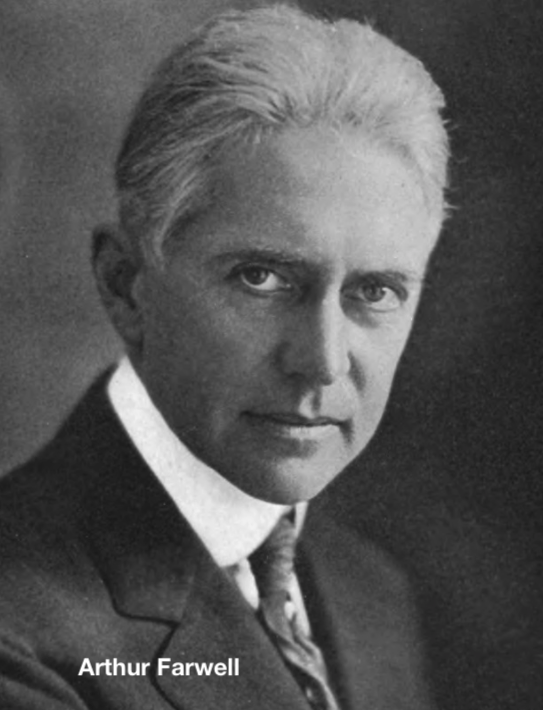[This short essay in WSJ Life & Arts “Masterpiece” style celebrates the October 22 NAXOS release of a new CD dedicated to American composer Arthur Farwell (1872-1952). Farwell focused the best of his creative energy to bringing Native American music and belief into symbiotic relationship with the means and practices of the Western concert music tradition. Farwell’s dynamic initiative, while proposing new compositional affinities, further sought to validate the indigenous component in American society, cultivating and expressing an American conscience.]
Arthur Farwell: a composer’s voice reaching to the sky
by Curt Cacioppo
Strewn over six decades are some half dozen inclusions of Arthur Farwell’s music on compilation LPs and CDs – a five minute orchestra piece here, a set of songs there, a solo piano piece or two. Such paltry representation and neglect of a figure whose visionary impact on music in the U.S. during his lifetime was felt from coast to coast and in between is nothing short of a mystery. A valiant reading of his Op. 103 Piano Quintet by the Pacifica Quartet and Aileen James came out on MHS in the 1970’s, which the company doesn’t even remember pressing. The much more recently issued 3 volume release of his complete piano music by the Cherokee pianist Lisa Cheryl Thomas made an ambitious move to address this. Now we have a new Naxos recording dedicated exclusively to Farwell’s most important corpus of work, produced in his prime, that resonates reverently, passionately, euphorically to the Native American influences and inspiration essential in his formation. Arthur Farwell: America’s Neglected Composer – Songs, choral and piano works, and the world premiere issue of “The Hako” string quartet, Op. 65 (1923), included in the label’s “American Classics” series, presents seven fascinating pieces in a variety of genres superbly performed by an international roster of the finest interpreters. Compelling liner notes by Joseph Horowitz, founder of the PostClassical Ensemble, which centerpins the project, accompany the album.
Without doubt, The Hako is Farwell’s longest sustained discourse in this vein, and the culmination of his quarter century long search for aesthetic complementation with the indigenous elements that beckoned to him from an early age. This 18 minute continuous narrative, informed by the Hako ceremony of the Pawnee, brings Native liturgy and melos, Western tonality and instrumentation, to common ground. Sonata form bows to the parameters of the ceremony, melodic content is shaped entirely in accordance with tropes and rhythms characteristic to the ceremony’s song repertoire. Farwell’s rhetorical pattern of intimation later manifesting in revelation follows the ceremony’s fundamental interrogative/declarative structure. At the outset, the ku´rahus, or leader of the Hako, incants: “I know not if the voice of man can reach to the sky, I know not if my prayers will truly be heard.” By the end of many days of devout ritual, he is able to exult: “I know now that the voice of man can reach to the sky, I know now that my prayers will truly be heard.”
The ceremony, received by the Pawnee as a gift from the Omaha tribe who originated it, serves multiple ends, among them as an initiation rite for the young, a mechanism for strengthening social solidarity, an entreaty for fruitful multiplication, an opportunity for thanksgiving. It was recorded collaboratively at the previous turn of century by Chaui Pawnee ku´rahus Tahirŭssawichi, James R. Murie (also Pawnee), and ethnographer Alice C. Fletcher. Edwin Tracy carried out the transcription of its more than 100 songs, which were graphophone recorded. The name of the ceremony embodies all of its components – vestments and paraphernalia, symbolic gesture and image, textual volume roughly equivalent to the combined linear content of the first and fourth Gospels, as well as music – and further implies the power of all of them “to speak.” The enactment unfolds in 20 core rituals grouped into 4 divisions.
In his Op. 65, Farwell surpasses all previous efforts, including his own, at attempting such cross-cultural coalescence. The process and result seem sui generis until we encounter, a generation later, a Native composer who conversely embraced Western musical tradition: Louis Ballard (1931-2007). Ballard, part Quapaw and part Cherokee, was descended from chiefs on both sides of his family, and grew up learning the cultural practices of his people. At the same time, he pursued a musical path of study at the University of Tulsa with Béla Rózsa, and a career that took him to New York City and the celebrated capitals of Europe. Louis felt himself at once an avowed post-Schoenbergian and thoroughly Indian. Ultimately he said, pointing to one of his scores, “This is not Native American music or any type of music other than ‘Louis Ballard music.’” Now that we are finally able to hear and take measure of Farwell’s Hako quartet, and reflect upon its genesis and intent, it becomes clear what exact counterparts he and Ballard are in historical relation to each other, each searching for synthesis, each writing his music, each shining a light toward compositional advancement. The parallel conjures up the Hopi twins at the North and South poles, who keep the planet rotating. Each composer takes the cultural inheritance bequeathed and entrusted to him and pools it with resources of the other in an effort to define his individual artistic identity, consequently widening and enriching the art.

The Dakota String Quartet outside the National Museum of the American Indian in Washington, D.C., on the occasion of their world premiere Naxos recording of Farwell’s most consequential work, The Hako. (Photo courtesy of the South Dakota Symphony Orchestra)

